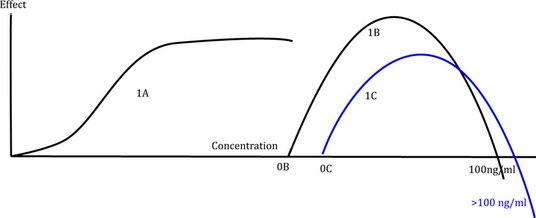Chronic-pain-science
HYPOTHESES
Fig.1A: plateau type curve
Fig.1B: Bell-curve type
Fig.1C: combination
According to the original results (Copyright: Medical Hypotheses: Elsevier) of Horrobin and Manku from 1977.
These results are the basics of thinking about the genesis of CRPS from a location with chronic pain.
Hypothesis II:
CRPS A contingent hypothesis with prostaglandins as crucial conversion factor.
Abstract
CRPS is an acute pain disease expressed as chronic pain with a severe loss of tissue and function. CRPS usually occurs after minor injuries and then progresses in a way that is scarcely controllable, or completely uncontrollable. This article addresses the functional control mechanism of a biological organism, a comparison of techniques, and the way the
negative feedback mechanisms fail in regulated feedback systems.
The measurement and regulation system is controlled at the local, regional, and central levels in a biological system.
Locally generated substances such as prostaglandins and hormones, as well as the central nervous system, play important roles in this process. Prostaglandins fulfil many conversion functions and are involved in vasoactive processes, pain, and inflammation. They play an intermediating role between the activity of the autonomic nervous system and local occurrences. The insufficiently explored conversion function of prostaglandins as a ubiquitously present cofactor may be related to the development of CRPS at sites which have had minor injuries in the past.
Relevance
Chronic Regional Pain Syndrome (CRPS) is a moderately prevalent disease, which occurs more frequently with age.
Even though there are diseases known to have a precipitating effect on the aetiology of CRPS, for example Carpal tunnel
syndrome, the mechanism of onset is unknown. The disease falls under the category of chronic pain, and seldom has an
effective treatment based on scientific research. The economic and psychosocial aspects of the disease are substantial.
Hypothesis
CRPS is the final position of a positive feedback measurement and control system.
Background of the hypothesis
Homoeostasis is directed by measurement and control processes. In electronics, a rapid conversion system, which quickly adapts to changing circumstances, superimposed with a delayed conversion system, which ensures a stable basis of homoeostasis. Measured changes are compensatorily controlled. An analogy is expected for a Complex
Adaptive System such as a living organism. Hormonal systems are slow systems, suitable for stabilising activity. Neural reflex systems function quickly. Prostaglandins that come from local tissue may be the link between the slow and rapid control.
In electronics, negative feedback can convert into a feedback loop which results in the dysregulation, which is what prostaglandins do in biochemistry. A feedback control mechanism only has two positions: a zero position and a final position. The process is not easily influenced by other factors.
Only phase shifting and signal weakness can affect the ( end of the abstract)
DOI: http://dx.doi.org/10.1016/j.mehy.2015.07.017
P.H.E. van der Veen.
Translation: Medical translations: Maastricht: Paulien Copper.
Veen PHE van der. CRPS A contingent hypothesis with prostaglandins as crucial conversion factor. DOI: http://dx.doi.org/10.1016/j.mehy.2015.07.017.
2015-july-26
SIx articles are accepted for publication:
Veen PHE van der, Martens EP. Viscerocutaneous reflexes with abdominal wall pain: A study conducted in 1981 on pregnant women from a general practice. Thermography international. 2013;23(2): 56-63
Available at:
http://www.uhlen.at/thermology-international/index.php
Veen PHE van der. Viscero-cutaneous reflexes in relation to abdominal and pelvic pain. A study from 1982 in females with IUD insertions. Thermography international. 2013;23(3): 87-92
Available at:
http://www.uhlen.at/thermology-international/index.php
Veen PHE van der. Infrared thermography for pain influenced by a Xanthine derivative: An attempt to assess chronic pain objectively.
Thermology international Vol 24 (2014), No. 2: 39-48
Available at:
http://www.uhlen.at/thermology-international/index.php
Abdominal Wall Pain:
Veen PHE van der. Effects of Placebo Measured by Infrared Thermography.
Thermology international 2014, 24(4) 157-165
Available at:
http://www.uhlen.at/thermology-international/index.php
Veen PHE van der. A theoretical model of biochemical control engineering based on the relation between oestrogens/progestagens and prostaglandins. DOI: http://dx.doi.org/10.1016/j.mehy.2015.02.021
Publication stage: Final version published online: 29-APR-2015 Full bibliographic details: Medical Hypotheses 84 (2015), pp. 557-569 DOI information: 10.1016/j.mehy.2015.02.021
Veen PHE van der. CRPS A contingent hypothesis with prostaglandins as crucial conversion factor.
Medical Hypotheses. 85 (2015) 568-575. DOI information: http://dx.doi.org/10.1016/j.mehy.2015.07.017.
